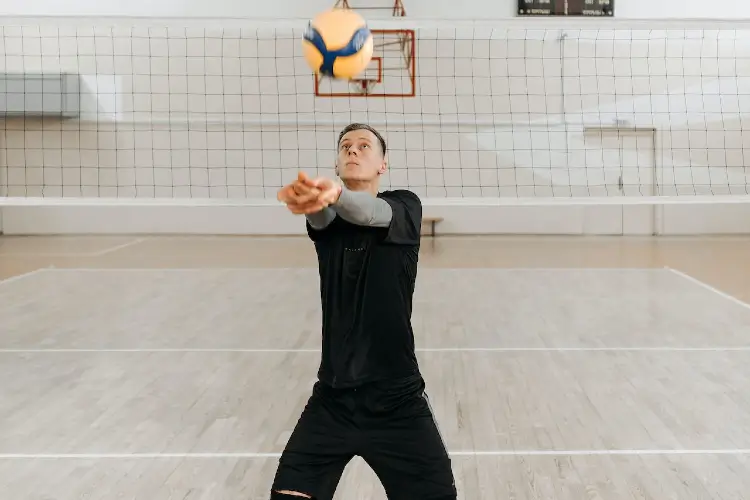Last Updated: January 9, 2024
Skilled volleyball players with proficient passing and receiving skills can put a team in a good position to influence victory. On the other hand, players that lack these skills can cause a team to lose matches.
Here are some common passing and receiving mistakes to avoid and correct to win matches for your team in 2023.
Common Passing Mistakes

Overpassing
Overpassing is a passing mistake that occurs when the volleyball is hit too high or hard, causing the ball to go directly over the net. The opposing team gets an easy scoring opportunity since the ball goes over the net uncontested. When facing challenging opponents, overpassing cannot be entirely avoided. However, players should develop solid passing and receiving skills to minimize its occurrence.
This can be achieved by practicing passing and receiving techniques in different game situations. Generally, it takes good practice to gauge the power of the incoming serve or attack to adjust your force. You should use a softer touch for fast and hard serves or attacks while aiming for a controlled pass. A firmer touch would be appropriate for less powerful volleyball serves or attacks.
Turning away from the ball
When you do not face the volleyball, the view of the ball will get obstructed. As a result, you may end up misjudging the ball’s trajectory, causing you to make poor choices on the court. Moreover, it’s going to reduce your reaction time, preventing you from covering the assigned court area effectively. And you won’t be able to move to a proper passing stance in time.
To avoid this mistake, always be prepared to move quickly. This will give you enough reaction time to adjust yourself properly as the ball approaches. While maintaining a shoulder-width stance, square up your upper body to the net to face the ball during a pass. You can practice by passing the ball back and forth with a partner while focusing on squaring up your body against the net from various positions in the court.
Overswinging the forearms
Overswinging leads to a lack of ball control, causing erratic ball trajectory, making it challenging for your teammates to anticipate the ball’s path. Beginners typically commit this mistake, which causes them to make frequent passing errors. Ideally, over-swinging should be corrected early on in one’s career to not risk developing muscle memory for the wrong technique.
To prevent over-swinging, you should focus on minimizing hand movement. Once your hands connect with the ball, you should not swing your arms wildly. Your best bet would be to engage in drills that emphasize minimum hand movements. You can also ask your coach to observe your technique to remind you when you are overswinging. The constant reminder will help you learn the proper passing technique quickly.
Not freezing at the point of contact
It’s important to freeze yourself for 1-2 seconds before connecting with the ball. Freezing helps to minimize unwanted body swings, allowing the ball to move smoothly in its intended direction. The brief pause also provides a few extra seconds to position your hands better to create a solid platform for passing the ball.
To reinforce the freeze technique during any practice drills, you must pause briefly after every pass. Think of striking a pose for a picture. This will allow you to be in a stable position before connecting with the incoming ball. The timing is important as well. So, take feedback from your coach or an experienced player to see if you are freezing at the right time.
Ignoring good follow-through
Neglecting follow-throughs with your arms can affect the quality of the pass because it’s going to limit your control over the ball. When you don’t follow-through during a pass, the ball can sometimes take off unpredictably, causing it to deviate from the intended direction. When the passes don’t land on the intended spot consistently, the team score suffers.
Upon contact with the ball, you should practice completing the action by fully extending your arms and wrist in the direction of the ball. This is vital for directing the volleyball towards its intended target. After all, a nice follow-through minimizes ball spin, resulting in a more stable pass. By doing this, you can significantly improve your passing skills.
Not maintaining eye contact during a pass
Unlike experienced volleyball players, beginners underestimate the role of planning behind a successful pass. A successful pass requires a little bit of planning for proper execution. However, many players do not pay attention to their teammates when passing the ball, which makes it difficult for any teammate to handle the pass. The entire team looks less coordinated due to this.
As a passer, you should aim to maintain proper eye contact with your teammates, which will allow you to make a good pass. The player receiving the pass will also be in a better position to handle the ball. So, make it a point to prioritize communication during the practice sessions. Also, seek advice from your teammates to get suggestions for improvements. As you work on your eye contact skills, you will notice that you are getting better at team-engaging activities.
Common Receiving Mistakes
Waiting for the serve
Not actively moving to connect with the incoming ball leaves one with limited time to react. This makes it challenging to accurately gauge the ball’s trajectory. Consequently, one fails to position themselves well according to the ball’s path, leading to misjudgments and less ball control.
This can be easily avoided by actively moving to meet the ball rather than passively waiting for the ball. You should take small steps toward the ball’s anticipated direction as soon as the serve is initiated. The initial foot movement will give you some extra time to react to the serve better.
Bending the arms
Bending the arms is an unnecessary extra movement that can affect your ball receiving skills. Any time you bend your arms, the contact surface gets reduced. This makes it difficult to provide a flat and stable surface for ball reception. As a result, the ball can bounce off unpredictably, leading to misguided passes.
You must make a conscious effort towards not bending your arms at the time of ball reception. You will have to ensure that you are not bending them when receiving the ball and even after you have made the pass. Be mindful of this technique during your games and practice sessions. If possible, review footage to identify instances of arm/elbow bending.
Connecting with the ball too high
Connecting with the ball too high can be problematic. It’s an incorrect ball receiving technique that can cause the ball to bounce off unpredictably from your hands. After all, a high receive makes it difficult to control the ball’s trajectory. A volleyball received too high can also limit one’s ability to set it accurately.
To prevent this situation, you should focus on proper ball receiving strategies. Some players make the mistake of using their fingers or wrists to receive the ball. The preferred technique is to use the lower part of the forearms to receive the ball while maintaining a nice platform angle. The sweet spot is around the waist height or slightly lower.
Keeping hands on the knees
Keeping your hands on the knees makes it difficult to react to the opposing team’s attack because you lose some time while withdrawing your hands from the knees to position yourself correctly. Having the hands on the knees can also disrupt your balance by shifting your center of gravity slightly forward.
You can keep your hands on your knees to relax when there is a break but not when the game is going on. Ideally, you should focus on maintaining an athletic stance with your hands in front of your body. This will allow you to respond to the incoming ball quickly. It will also indicate your state of readiness, which will boost your team’s morale. So, make it a habit to not keep your hands on your knees.
Not wearing proper shoes
Wearing inappropriate shoes can impact both your passing and receiving skills. The shoes designed for volleyball usually have the right amount of cushioning on them to facilitate quick movements. They also come with necessary features like adequate shock absorption and sole patterns to provide sufficient grip, stability, and traction on the court. At the same time, they help in reducing injury risks.
To optimize performance on the court, including passing and receiving skills, all volleyball players must invest in proper volleyball shoes. Some brands specialize in volleyball shoes. It’s better to get your shoes from popular brands because well-made shoes from reputable brands usually come with all the necessary features to meet the demands of the sport sufficiently.
Conclusion
You must stay committed to refining your passing and receiving skills by minimizing the unnecessary mistakes to be a better player on the volleyball court. It’s vital not only for your success but also for your team’s success.
